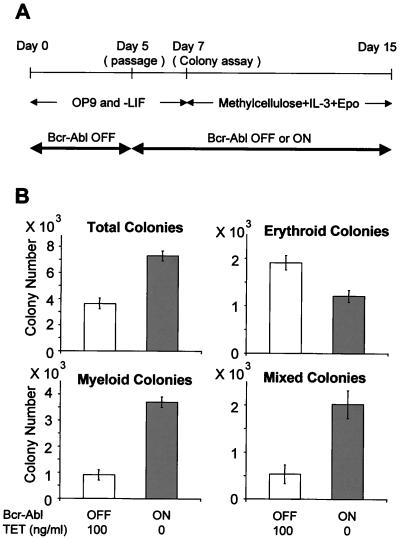Figure 3.
Effects of Bcr-Abl on early hematopoietic colony formation. Control and inducible Bcr-Abl ES cells were differentiated on OP9 stromal cell layers in the presence of Tet until day 5. At that point, these cells were divided into two subgroups: one was maintained with Tet, and the other was cultured in the absence of Tet. On day 7, clusters of immature hematopoietic cells had developed on the OP9 cell layers. The hematopoietic cells in these clusters were harvested and analyzed. (A) Experimental design of hematopoietic colony assays in methylcellulose culture. Inducible Bcr-Abl ES cells were differentiated on OP9 stromal cells with Tet (100 ng/ml) in the absence of LIF. On day 5, differentiated ES cells were harvested and seeded onto a new OP9 cell layer with or without Tet. On day 7, the hematopoietic cells developing on the OP9 cell layers were harvested and plated in methylcellulose cultures with recombinant IL-3 (10 ng/ml) and erythropoetin (2 units/ml) present (42). (B) Eight days later, colonies were counted and scored as to differentiated phenotype. Individual colonies were picked, and cytospin specimens were stained with Giemsa solution to confirm the colony types. Colonies containing more than 50 hemoglobinized cells were counted as erythroid. Open bars show the Tet (+) condition, in which the Bcr-Abl protein is suppressed. Filled bars indicate the Tet (−) condition, which results in the strong expression of Bcr-Abl protein. Colony numbers are represented as the calculated total present per culture harvested at day 7.

